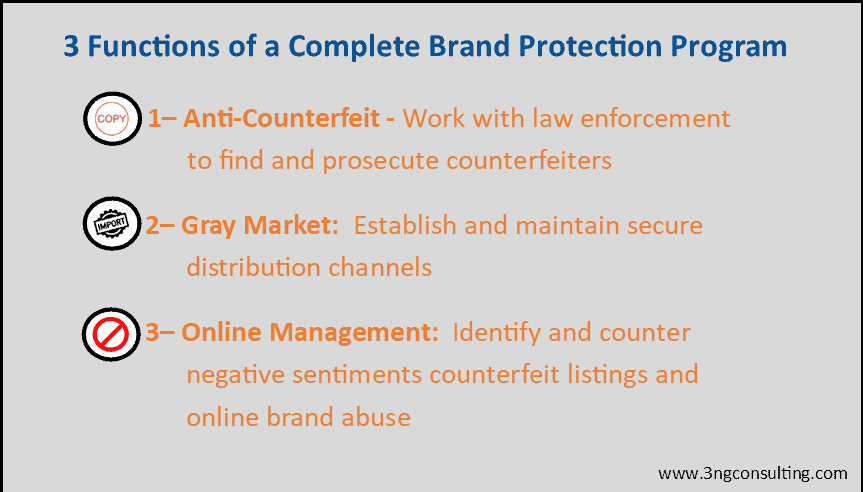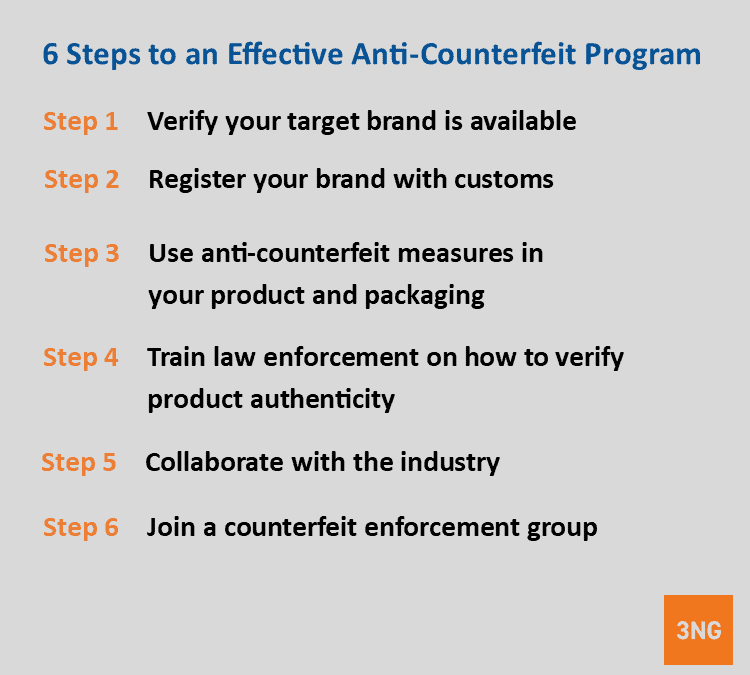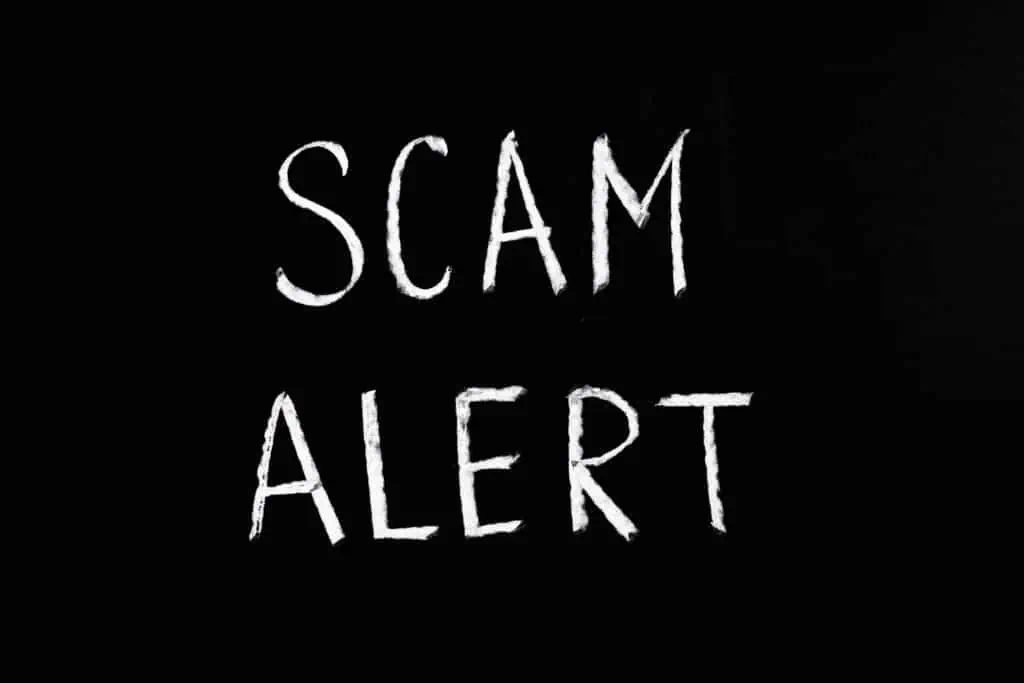Why do you need a brand protection strategy? It takes millions of dollars to build, nurture and create a brand. So, why stand by idlily while bad actors steal your brand identity for their financial gain.
Building a brand value is hard but stealing someone else’s brand is easy. And unless a brand owner makes the right moves, they are helpless to defend their brand investment. So, take a few minutes to set up some essential brand protection tools.
What is Brand Protection?
Brand Protection is the ongoing process of maintaining your brand integrity and includes 3 major functions
- Anti Counterfeit – Halting unauthorized use of your the brand by a manufacturer.
- Gray Market Enforcement – Pursuit of the sale of branded product through an unauthorized distribution channel.
- Online Brand Management – Active management of online presentation of your brand.

Battling Counterfeit
There are many counterfeit definitions, but at its core, counterfeit is the unauthorized use of a brand to produce goods. The production and sale of counterfeit goods is stealing, and it is a crime.
But beyond being a crime, the counterfeit items rob sales from the brand owner. And counterfeit parts are typically poor-quality imitations and can damage brand perception.
Counterfeiters build cheap product that’s just good enough to fool the consumers and regulators. And they have no incentive for quality control and use inferior materials and workmanship.
So, battling counterfeit is important for your company if you want to retain your product image. Fortunately, the law is on your side if you follow the right steps.
Step 1: Conduct a Brand Search
Although it seems obvious, your legal team should conduct a brand search to ensure your brand is not owned by another company. This protects you from legal action.
Step 2: Register your Brand
Law enforcement cannot prosecute infractions against unregistered brands. So, the first step in avoiding counterfeit parts is to register your brand with the right regulatory agencies.
Step 3: Use Counterfeit Prevention Measures
Add counterfeit protection technologies to your product design. Things such as sequential barcodes, watermarks, holograms and similar measures make it harder for counterfeiters to steal your product.
Step 4: Train Law Enforcement
Customs agents know the law, but they don’t know the finer points of your product authenticity. So, create and share product documentation with law enforcement. Because the more you do to make their job easy, the more likely they are to intercept and destroy counterfeit product.

Step 5: Collaborate with Others
Battling counterfeiters is expensive. So, work with other trademark owners in your industry. Since counterfeiting is an illegal activity, you can collaborate with your competitors to find bad actors.
Step 6: Join an Association
It can be difficult for a company to battle counterfeit on their own. An associate brings many members of an industry together into a trade group to combat counterfeit manufacturers.
Association membership extends each company’s resources and multiplies success. One excellent example of an effective organization is the automaker council – the A2C2
Managing Gray Market
Gray Market Definition – Grey market or parallel imports is the sale of authentic product through unauthorized distribution channel. Gray marketing is NOT an illegal activity. So, supply chain management to control gray market is the responsibility of the brand owner.
Gray market may not be a bad thing depending on your company’s position and needs. There are many examples of gray market goods both damaging and benefiting a brand. So, before combatting gray market it is best to understand how it is affecting your business.
For example, it may make sense to ignore an exporter who is selling your product to foreign markets you can’t reach. On the other hand, the importation of gray market goods can damage established distribution channels. What path you choose depends upon your circumstances.
In either case, it is best to formalize your distribution agreements to ensure channel control. Gray market is primarly managed through the enforcement of distributor agreements. So, informal distributor relationships create risk. So formalize your distributor agreements and make sure you include the language to enforce violations and expand/restrict territories.
Online Brand Protection Strategy
Protecting your brand online is a full-time function that involves 2 primary activities:
- Brand Reputation Management
- Online Counterfeit Enforcement
Brand Reputation Management
Up to 80% of brand research is conducted online and online sales are becoming more commonplace. So, online brand management is nearly as important as advertising in managing consumer opinions.
Online brand reputation management focuses on monitoring what is being said about your brand online. This process involves the use of brand protection software and human activity to monitor and manage your online reputation.
Companies should also have a brand response strategy and team to battle negative perceptions online.
Online Counterfeit Enforcement
Online marketplaces create opportunities for counterfeiters and offer tools for registered brand owners to protect against counterfeits. Marketplaces such as eBay and Amazon have robust brand protection tools to help remove counterfeit product from their sites.
Most online marketplaces have policies and pre-screening capabilities to control counterfeit parts. However, manufacturers need active brand protection teams to monitor and protect against the sale of counterfeit parts in online marketplaces.
Fortunately, there are brand protection companies who can provide effective online brand protection services. These companies use a combination of brand protection technology and online monitoring to find and remove counterfeit sellers from online marketplaces.
Some companies protect against brand abuse with an internal team. And there is plenty of brand protection software available to locate and remove counterfeit product from online marketplaces.
About 3NG Consulting
3NG Consulting is a full-service consulting company that can help you establish your brand protection strategy. Our team has the experience to help you find the right attorneys, investigators and form the right alliances.
Our brand protection team works under the view that Brand Protection is most effective when companies pool resources. Our team uses our experience in forming industry groups. And we can help your company find the right brand protection group for your product and industry.






